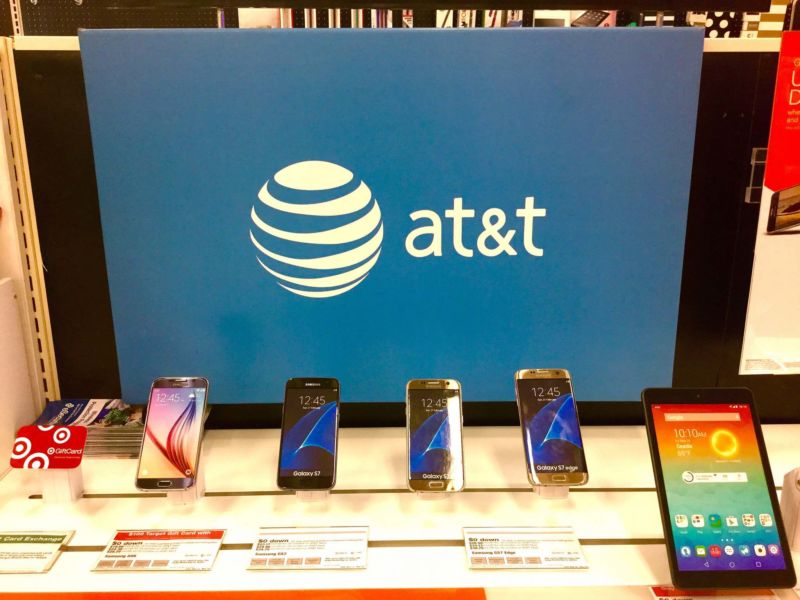
AT&T says its 5G wireless trials have been producing speeds of more than a gigabit per second from millimeter wave frequencies, even in bad weather and—in some cases—without a line-of-sight connection. Latencies have been as low as 9ms, the company said.
Current-generation 4G LTE networks generally use frequencies below 1GHz, which are best for covering long distances and penetrating obstacles such as building walls. 5G networks are expected to rely heavily on millimeter wave signals—30GHz and above—which are easily blocked by obstacles and generally require line-of-sight connections.
AT&T and other carriers plan to use 5G for smartphones connecting directly to mobile networks and for fixed wireless connections in areas that lack fiber-to-the-premises or cable. There is a lot of available millimeter wave spectrum, which means carriers can easily ramp up the bits per second. But there will be challenges in actually getting that data to smartphones when there are obstacles between the cell sites and handheld devices.
“Some non-line-of-sight conditions”
AT&T, however, says its early trials show that these problems can be overcome, at least in certain conditions. In South Bend, Indiana, AT&T set up a 5G trial for small business and residential customers. The trial "Successfully provided gigabit wireless speeds on mmWave spectrum in both line-of-sight and some non-line-of-sight conditions," AT&T said in an announcement yesterday.
That qualifier—"some non-line-of-sight conditions"—suggests that AT&T has been able to overcome the physical limitations of millimeter wave spectrum in only limited circumstances. AT&T didn't say what circumstances produced the positive result—we've asked the company for more details and will update this post if we get answers.
AT&T had other good news to report. In a trial involving small businesses in Kalamazoo, Michigan, AT&T "Observed no impacts on 5G mmWave signal performance due to rain, snow, or other weather events." AT&T said it also "learned [that] mmWave signals can penetrate materials such as significant foliage, glass, and even walls better than initially anticipated."
There was no suggestion that the Kalamazoo trial succeeded in any non-line-of-sight conditions. But AT&T said the trial produced gigabit speeds in line-of-sight conditions to users up to 900 feet away from the cell sites.
The other trial in Waco, Texas, "Provided 5G mmWave service to a retail location more than 150 meters away from the cell site and observed wireless speeds of approximately 1.2Gbps in a 400MHz channel," AT&T said.
The Waco trial also produced "latency rates at 9-12 milliseconds" and "supported hundreds of simultaneous connected users using the 5G network," AT&T said. It's not clear how many users were able to receive gigabit speeds simultaneously.
AT&T's average download speeds over 4G are below 15Mbps, according to a January 2018 report by testing firm OpenSignal.
Latency of 9 or 12 milliseconds could be a big improvement over 4G. AT&T led the industry "with an LTE network ping time of 58.3 milliseconds," the OpenSignal report said.
AT&T presumably only reported the best results from its trials, so the average 5G latency from the trials might have been higher than 9 or 12ms. Still, the shift from 4G to 5G is expected to reduce latency and boost speeds industry-wide. AT&T says that 5G's low latency will help support communication between self-driving cars, for example. And the best 5G latencies could end up being lower than 9ms, as AT&T has said that "the industry expectation for 5G is latency less than 5 milliseconds."
Even after mobile services over millimeter-wave spectrum are widely available, the high frequencies will be a complement to existing networks rather than a full replacement. Carriers will use millimeter waves to improve their networks where they're able to, but they won't abandon the sub-1GHz spectrum that's so effective at covering virtually the entire United States.
UPDATE: An AT&T spokesperson some of our questions after this article published. The 5G trials established connectivity at each site with fixed wireless networks, and individual users accessed the networks via Wi-Fi from "a variety of mobile devices" including smartphones and tablets, AT&T said. While fixed wireless is obviously different from mobile, AT&T said that "the learnings about mmWave that we gained during the trials will guide our mobile deployments, since those will also use mmWave spectrum."
AT&T also gave us more detail on how the test networks performed in line-of-sight and non-line-of-sight conditions:
Both propagation measurements and our trials are showing mmWave performing better than expected in the 28 and 39Ghz band in both line of sight and non-line of sight conditions. Specifically in NLOS conditions, we’ve seen the signal perform well despite foliage and building structures. We’ve also been testing adaptive beamforming and beam tracking to enable non-line-of-sight 5G services in our trials. In terms of bad weather, especially at our Austin trial, we have not seen any observable signal degradation due to weather and the trials have lasted multiple months through all kinds of rainfall.
5G phones not ready yet
AT&T said its goal is "to be the first US carrier to launch standards-based, mobile 5G services to customers this year." It will be available "in a dozen markets by late 2018," the company says.
We recently asked AT&T if the shift to 5G will be accompanied by less strict throttling policies, but the company hasn't revealed anything on that topic yet. Currently, AT&T reserves the right to throttle customers with "unlimited" 4G data plans if they use more than 22GB in a month and connect to a congested cell tower.
Verizon plans to launch 5G home Internet this year, T-Mobile says it plans to build out 5G mobile networks in 30 cities this year, and Sprint is aiming for 2019.
Even if AT&T beats the other carriers to 5G by a few months, it wouldn't be that big of a deal because 5G-capable smartphones won't be widely available this year. AT&T has said that it will offer a device capable of connecting to 5G networks this year, but, in general, 5G-capable phones appear to be on track for wider release in 2019 and beyond.
reader comments
143